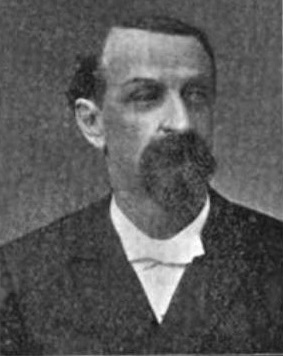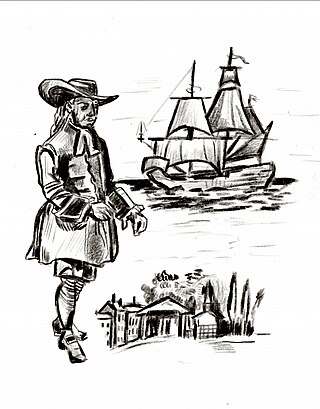
David Benjamin Updegraff, also David Updegraff, David B. Updegraff and Rev. David Updegraff (January 24, 1789 - December 20, 1864) was an American Quaker minister, abolitionist and conductor of a station of the Underground Railroad from Ohio.

David Benjamin Updegraff, also David Updegraff, David B. Updegraff and Rev. David Updegraff (January 24, 1789 - December 20, 1864) was an American Quaker minister, abolitionist and conductor of a station of the Underground Railroad from Ohio.
David Benjamin Updegraff was born as son of Nathan Updegraff, a founder and delegate to Ohio's first constitutional convention, and Anne Updegraff (née Lupton). He descendants from a long line of ministers and elders of the Quaker church, [1] which belong to the Op den Graeffs, a German family of Dutch origin. [2] He was a direct descendant of Herman op den Graeff, mennonite leader of Krefeld, and his grandson Abraham op den Graeff, one of the founders of Germantown and in 1688 signer of the first protest against slavery in colonial America.
David growing up in Winchester, Virginia, but in 1802 [3] he moved with his family to Mount Pleasant, Jefferson, Ohio. [4] Like his ancestors he owned a farm. He also served as a minister for the Society of Friends (Quakers). In 1812 he married with Rebecca Taylor Updegraff (1790-1867). She worked as a well-regarded Quaker minister. Like his well known Updegraff-ancestors the couple were actively involved in the anti-slavery movement. They were members of the Anti-Slavery League and used their house as a station on the Underground Railroad. [5] It was the home of anti-slavery advocats and temperance lectures. [3]

David Benjamin and Rebecca Taylor Updegraff had eight children: [3]

There is a reference about the Op den Graeff glass paintings of Krefeld with a description of Herman op den Graeffs possible, but not proven coat of Arms was found in the estate of W. Niepoth (op den Graeff folder) in the archives of the city of Krefeld, who noted a letter dated November 17, 1935 from Richard Wolfferts to Dr Risler: Saw the Coat of Arms glass pane in the old museum: 'Herman op den Graeff und Grietgen syn housfrau' or the like. Coat of Arms - In the sign a silver swan in blue. Helmet decoration (I think): Swan growing. [6]

Mount Pleasant is a village in southern Jefferson County, Ohio, United States. The population was 394 at the 2020 census. It is part of the Weirton–Steubenville metropolitan area. Founded in 1803 by anti-slavery Quakers, the village was an early center of abolitionist activity and a well-known haven for fugitive slaves on the Underground Railroad.

Krefeld, also spelled Crefeld until 1925, is a city in North Rhine-Westphalia, Germany. It is located northwest of Düsseldorf, its center lying just a few kilometers to the west of the river Rhine; the borough of Uerdingen is situated directly on the Rhine. Because of its economic past, Krefeld is often referred to as the "Velvet and Silk City". It is accessed by the autobahns A57 (Cologne–Nijmegen) and A44 (Aachen–Düsseldorf–Dortmund–Kassel).

George Keith was a Scottish religious leader, a Presbyterian turned Quaker turned Anglican. He was born in Peterhead, Aberdeenshire, Scotland, to a Presbyterian family and received an M.A. from the University of Aberdeen. Keith joined the Religious Society of Friends (Quakers) in the 1660s, accompanying George Fox, William Penn, and Robert Barclay on a mission to the Netherlands and Germany in 1677.

David Upthegrove is an American politician. He is a member of the King County Council, representing the 5th district since 2014. A member of the Democratic Party, he was a member of the Washington House of Representatives, representing the 33rd district from 2002 to 2013.
Upthegrove Beach is an unincorporated community in Okeechobee County, Florida, United States. It is located on US 441/US 98, on the northeastern shore of Lake Okeechobee.

Francis Daniel Pastorius was a German-born educator, lawyer, poet, and public official. He was the founder of Germantown, Pennsylvania, now part of Philadelphia, the first permanent German-American settlement and the gateway for subsequent emigrants from Germany.

The Religious Society of Friends, better known as the Quakers, played a major role in the abolition movement against slavery in both the United Kingdom and in the United States. Quakers were among the first white people to denounce slavery in the American colonies and Europe, and the Society of Friends became the first organization to take a collective stand against both slavery and the slave trade, later spearheading the international and ecumenical campaigns against slavery.

Thomas Updegraff was an American attorney, politician, and five-term Republican member of the U.S. House of Representatives from northeastern Iowa. His two periods of service were separated by ten years out of Congress.

Jonathan Taylor Updegraff was an American physician, abolitionist and politician who served as a U.S. Representative from Ohio from 1879 to 1882.

The 1688 Germantown Quaker Petition Against Slavery was the first protest against enslavement of Africans made by a religious body in the Thirteen Colonies. Francis Daniel Pastorius authored the petition; he and the three other Quakers living in Germantown, Pennsylvania, Garret Hendericks, Derick op den Graeff, and Abraham op den Graeff, signed it on behalf of the Germantown Meeting of the Religious Society of Friends. Clearly a highly controversial document, Friends forwarded it up the hierarchical chain of their administrative structure—monthly, quarterly, and yearly meetings—without either approving or rejecting it. The petition effectively disappeared for 150 years into Philadelphia Yearly Meeting's capacious archives; but upon rediscovery in 1844 by Philadelphia antiquarian Nathan Kite, latter-day abolitionists published it in 1844 in The Friend, in support of their antislavery agitation.

Herman op den Graeff, also Hermann was a Mennonite community leader from Krefeld.
Stephen Updegraff, M.D., FACS is an American refractive surgeon best known for his early involvement in, and contributions to, LASIK. He is a Fellow of the American College of Surgeons, a board-certified member of the American Board of Ophthalmology, a founding member of the American College of Ophthalmic Surgeons, and a member of the International Society of Refractive Surgery, the American Academy of Ophthalmology, the American Society of Cataract and Refractive Surgery, and the Pine Ridge Eye Study Society. Updegraff currently serves as the medical director of Updegraff Vision in St. Petersburg, Florida.

Abraham Isaacs op den Graeff, also Op den Graff , Opdengraef as well as Op den Gräff was one of the so-called Original 13, the first closed group of German emigrants to North America, and an original founder of Germantown, Pennsylvania, as well as a civic leader, member of the Pennsylvania Provincial Assembly, award-winning weaver, and as an early abolitionist signer of the first organized religious protest against slavery in colonial America. He, or his brother Derick op den Graeff, are briefly mentioned in John Greenleaf Whittier's poem "The Pennsylvania Pilgrim" simply as "Op Den Graaf".
Op den Graeff is a German and American family of Dutch origin. They were one of the first families of the Mennonite faith in Krefeld at the beginning of the 17th century. Various family members belonged to Original 13, the first organized immigration of a closed group of Germans to America in 1683. There the family had a long history in religious service and politics, beginning in the late 17th century in the Colony of Pennsylvania. In 1688, they became forerunners of the anti-slavery movement by signing the first anti-slavery protest in North America. Their descendants spread into various lines, Updegraff, Uptegraft, Updegraft, Updegrave, Updegrove, Uptegrove, Ubdegrove, Uptegraph, Upthagrove. The Updegraff branch of Ohio belonged to the leading families of the Quaker religious movement and produced a long line of ministers and elders.
Edgar Rice Updegraff was an American amateur golfer and urologist.
Allan Eugene Updegraff (1883–1965) was an American-born novelist, poet, and editor. After he and his friend, Sinclair Lewis, dropped out of Yale during his junior year, he made a living working odd jobs, as well as writing stories for magazines and newspapers. In 1917 he had his first novel published. He moved to Paris in the mid 1920s, where he lived until his death in 1965. In addition to his six novels, he published poetry, short stories and essays, as well as having a short stint as a book reviewer.
Laura Beatrice Upthegrove Swindal was a 20th-century American outlaw, bank robber, bootlegger, and occasional pirate active in southern Florida during the 1910s and 1920s, along with John Ashley. From 1915 to 1924, the Ashley Gang operated from various hideouts in the Florida Everglades. The gang robbed nearly $1 million from at least 40 banks while at the same time hijacking numerous shipments of illegal whiskey being smuggled into the state from the Bahamas. Ashley's gang was so effective that rum-running on the Florida coast virtually ceased while the gang was active. Ashley's two-man raid on the West End, Grand Bahama, in 1924 marked the first time in over a century that American pirates had attacked a British Crown colony.

Derick Isaacs op den Graeff, also Dirk, Dirck, Derrick Isaacs op den Graeff, Opdengraef, Opdengraff as well as Op den Gräff was one of the so-called Original 13, the first closed group of German emigrants to North America, an original founder of Germantown, Pennsylvania, as well as a civic leader. As an early abolitionist He was a signer of the first organized religious protest against slavery in colonial America. He, or his brother Abraham op den Graeff, are briefly mentioned in John Greenleaf Whittier's poem "The Pennsylvania Pilgrim" simply as "Op Den Graaf".

Nathan Updegraff was an American Quaker minister, abolitionist and founder and delegate to Ohio's first constitutional convention in 1802.

Herman Isacks op den Graeff, also Herman op den Graeff, Opdengraef, Opdengraff as well as Op den Gräff was one of the so-called Original 13, the first closed group of German emigrants to North America and an original founder of Germantown, Pennsylvania. He was an outspoken anti slavery man and abolitionist.